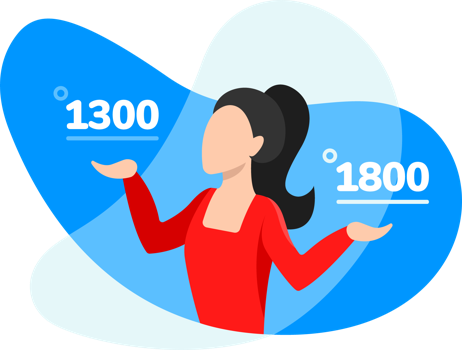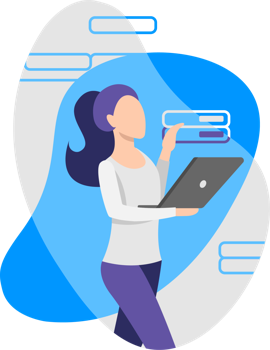Buying a 1300 number in Australia
A business 1300 number is a 10 digit phone number that acts as a single point of contact for callers across Australia. There are a large number of 1300 number plan providers with lots of different costs and charges.
Consider these points when getting a 1300 number.
- What is the total monthly cost to have the 1300 number configured to your exact business needs?
- 1300 number contract terms and conditions
- Quality of the provider of the 1300 number and the network
The most important point to remember is to read the Critical Information Summary for the 1300 plan which will provide all the information you need to know about that particular plan, and will allow you to compare plans from different providers.
Choosing a 1300 number provider
There are so many 1300 number suppliers on the market it can be hard to figure out which one is best for your business.
A good starting point is to choose a company that:
- Is Australian, so you have access to all recourses (like the TIO) if something goes wrong
- Has local, knowledgeable teams to support you instead of an overseas call centre
- Sends calls only over the high quality Australian telecommunications network (rather than the cheaper and poorer quality international networks)
- Has simple pricing so you know exactly what you're paying for
How much does a 1300 number cost?
Depending on the service provider, costs for a 1300 number vary quite a lot. A typical 1300 number plan has four elements.
- Monthly plan fee (also called a hosting fee)
- Call rates (what you pay to receive a 1300 call, or $0 for an unlimited 1300 number plan)
- Optional features and functionality access fee (pay per feature, per feature set, or have it included in the cost of your monthly 1300 number hosting fee)
- Set up fee (for new numbers or when porting a number to a new provider)
Some 1300 number providers charge minimum monthly fees, and support fees if you need to change your routing or cancel your number. The Critical Information Summary will outline all the 1300 number costs.
The format and structure of a Critical Information Summary (“CIS”) is mandated in telco law in Australia. Communications Compliance guides 1300 number service providers on what a CIS must contain and how it must be laid out.
1300 number call rates
If you don’t have a 1300 number plan with $0 call rates you will pay to receive 1300 calls. The best call rates are charged per minute and calculated in per-second increments (not in 10 seconds increments). The proportion of hosting fee to call rates is usually an inverse ratio, so the higher your call rates the lower your monthly plan fee.
How much is a 1300 number?
For typical small business users, a 1300 number costs less than $100 per month and businesses with a higher call volume will pay around $400 to $800 per month. Large enterprises typically have monthly 1300 number bills that runs into the thousands or tens of thousands.
Compare 1300 number plans
Comparing 1300 number plans can be tricky because there are lots of different providers with a wide variety of charging methods. It’s best to find a provider that can offer you certainty of billing, like with an unlimited 1300 number plan which always charges the same amount every month regardless of how many calls are received (because all calls are included free of charge).
The best method is to calculate the total monthly 1300 number cost based on a hypothetical Australian business that uses around 300 minutes per month (or around 5 calls per day).
Cheap 1300 numbers
1300 number Australia costs are cheap. The value a 1300 number brings is well worth the cost because you can better manage your business phone calls and can see the ROI of any marketing spend through advanced reporting tools.
Cheapest 1300 number providers can sometimes have lower quality networks (some send calls over international networks) so make sure to ask whether calls will be sent only over the high quality Australian telecommunications network.
Difference between 1300 and 1800 numbers
There is no difference in functionality between a 1300 and 1800 number. Both are 10 digit premium phone number services designed for Australian businesses. They come with advanced call management features to route calls according to specific business needs, and also provide call records to analyse caller behaviour which helps to predict trends and to calculate the ROI on any marketing budget spend.
The only difference between 1300 and 1800 numbers is the cost - 1800 numbers typically cost a business owner more in terms of monthly hosting fees and call rates, whereas 1300 numbers can cost a small fee to call (usually no more than 25 or 30 cents per call).
1300 vs 1800
Deciding between a 1300 or 1800 really depends on the type of business and on the preferred charges for callers. Freephone 1800 numbers are used by not-for-profit and information-providing service businesses (a 1800 is always free to call from Australia so it makes sense for these types of businesses). Business 1300 numbers are used by private companies selling goods and services either B2B or B2C.
It can cost callers a small fee to ring a 1300 number, but most mobile users in Australia have an unlimited call plan which includes the cost of calling a 1300 number. Calls to a 1800 number are always free of charge when the caller rings from a landline or mobile in Australia.
Rent vs buy a 1300 number
Leasing a 1300 number sometimes makes sense, but rarely. Consider these three compelling reasons not to rent a 1300 number.
- You're tied to the service provider who owns the number and can't port away if the fees suddenly increase or the service quality decreases.
- The leasing provider can remove the 1300 number from circulation (or sell it to a buyer with deep pockets) leaving a business stuck with expensive marketing or stationery costs.
- There is no guarantee of exclusivity. If a business operates in a limited geographical market, the provider could sub-lease the same 1300 number to another business based in a similarly limited market elsewhere in Australia.
How to buy a 1300 number
First decide which is best - a free 1300 number (that a provider already has in their pool of available 1300 numbers) or a specific 1300 number that spells a word or has a memorable sequence of digits (such as 1300 NUMBER or 1300 987 654).
Then find a provider that offers a 1300 plan without high call rates or additional fees. As there are many different types of 1300 number plan, review each Critical Information Summary to compare like with like (the CIS will also outline any hidden fees that some telcos love to leave buried in extensive documentation).
1300 number availability
Over 300,000 businesses across Australia use 1300 numbers, but there are over 1,000,000 combinations of 1300 phone numbers so there’s plenty of availability. The best way to find an available 1300 number is via the ACMA search page to do a 1300 number lookup.
ACMA 1300 number lookup
ACMA lists all the available phone numbers for a search term (using numbers or phone words including 1300 Smartnumbers) as well as the once-off purchase price which ranges from $250 to $20,000. Avoid payingan upfront purchase price by choosing from any provider’s list of available free 1300 numbers.
1300 Smart numbers
A Smart number is a 1300 number that spells a word (like 1300 NUMBER / 1300 686237) or has a memorable sequence of digits (such as 1300 987 654). Buying an available 1300 number from ACMA means you have bought a Smartnumber and will need to connect the number to the network with a 1300 number host provider.
1300 number hosting
In order to receive calls on a 1300 number, it must be hosted on the Australian telecommunications network with a 1300 number host. As long as a number remains connected to the network and you are the owner of that 1300 number (the EROU holder), you are free to switch providers (also referred to as ‘porting’ a number) to find a better deal at any time.
There are strict rules around the porting or switching of 1300 numbers between host providers, including time limits and verification of accounts (typically by seeing a recent invoice).
1300 number plans
1300 number plan structures vary across providers so the legally-required Critical Information Summary is a helpful way to compare 1300 number plans. Typical plans have the following elements.
- Monthly number hosting fee (also called a management fee)
- Unlimited calls included, or call rates (the price you will pay to receive a 1300 call)
- For new numbers, a once-off setup fee (usually no more than $25)
Some 1300 numbers providers will also charge support fees, account fees, or change fees (if you want to update where you answer calls) which is why it’s so important to read the Critical Information Summary provided for each plan.
1300 number charges
1300 numbers attract a whole host of different charges, all of which will be outlined in a Critical Information Summary document.
Typical charges include:
- Monthly hosting / management fee
- Call rates (unless you have an unlimited 1300 number plan with all calls included)
- Plan setup fees
- Professional voiceover recording fees (for personalised pre-connection greetings, voicemails, or IVR features)
Non-typical charges may also be included, and 1300 number providers that charge these fees should be avoided at all costs.
- Features activation / deactivation fees (these are often charged monthly)
- Credit card or debit card fees
- Plan change fees
- Cancellation / port-away fees
- General support or enquiry fees
- Port-in fees
- Complex configuration change fees
- Account administration fees
- Payment dishonour fees
- Feature setup fee (for example, setup fees to program an IVR or an area-based routing configuration)
- Routing configuration change fees
- After-hours support fees
- Quarantine fees
- Quarantine release fees
Configuring a 1300 number
A 1300 number isn’t just a replacement for a local area phone number (02, 03, 07 or 08). There are heaps of features and functionality to route 1300 business calls to different phone numbers, departments and voicemails during business hours and out of hours. So, 1300 numbers are an excellent substitute for a PBX business phone system for smaller businesses who can’t afford that expense.
Ring multiple phones
A 1300 number is also called a virtual phone number, which means there are no traditional phone lines associated with it. Calls to a 1300 number are diverted / forwarded to existing phone lines, including mobiles, landlines and VoIP, also called ‘answerpoints.’
There can be multiple types of answerpoints for a single 1300 number, and routing can be configured in many different ways, three of which are listed below.
- Simultaneous ring - all phones ring at the same time (and whoever answers first takes the call)
- Consecutive ring - first ring phone number 1, if no answer then ring phone number 2, etc
- Round robin - phone call 1 goes to answerpoint 1, phone call 2 to answerpoint 2, and so on (especially great for sales teams)
Time of day routing
A 1300 can be configured to send calls to one or more numbers during business hours, and to another service (or another team) during after-hours periods.
A common setup is to divert calls received outside of business hours straight to a voicemail, or even to a live phone answering call centre to take messages on behalf of the business.
Pre-connection greeting
A personalised professional recording that is played to all callers confirming they have called the correct business. A typical script is, “Thanks for calling [my business], Australia’s best [service provider]. Your call is important to us and someone will be right with you.”
Call Whisper
Small businesses often divert their 1300 number straight to a mobile which is also used to receive personal calls. The Call Whisper feature plays a short recording when a mobile is answered that says, “This is a 1300 call” to identify the call as a business call.
Voicemail to email
People rarely listen to their voicemails any more because it’s a hassle to retrieve the file. With this 1300 number feature when a caller leaves a voicemail an email with the audio file attached is sent so you can automatically upload these into your CRM and keep track of all contact with a given customer.
IVR
An IVR (Interactive Voice Prompt) is a pre-recorded audio file played to every caller that prompts them to enter a number on their phone dialpad to be connected to the right department or person. A common example is, “Thanks for calling [my business], please press 1 to speak to Sales, press 2 for Accounts.”
An IVR can also have multiple levels, so if a caller presses option 1, they can be presented with more options to choose from. So if someone presses 1 for Sales, the next level IVR might ask them to press 1 if they’re an existing customer, or press 2 for new customers.
Reporting
1300 numbers come with powerful reporting and analytics capability. All calls are logged which means callers’ behaviour can be analysed to determine the best possible spend of a business’ marketing budget since the ROI data is tracked.






